Adrian Collins's Blog, page 28
February 23, 2025
REVIEW: Greenteeth by Molly O’Neill
Well, I never thought another author would actually come close to the cozy dark fairytale-esque storytelling of T. Kingfisher for me, but Molly O’Neill proved me wrong in Greenteeth. Brimming with Celtic/British legends and folklore, loveable monsters, strong found family vibes, and lots of humour and heart, this is a deeply immersive and atmospheric fairytale-esque quest adventure with sharp teeth but a soft heart.
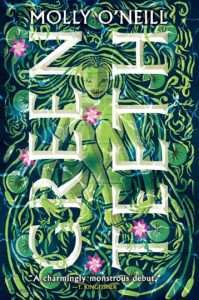 Now, I don’t know what I was expecting from Greenteeth, but it really surprised me in all the best ways. I mean, just listen to this wicked premise: a lake monster, a witch, a hobgoblin, and their trusty four-footer embark on an heroic magical quest throughout the mystical lands of Britain, Wales, Scotland, and faerie realms to defeat an ancient evil that threatens not just their home, but the very soul of Britain. It might sound like a lot, but somehow O’Neill pulls off her uniquely wild and charming vision for Greenteeth with effortless grace.
Now, I don’t know what I was expecting from Greenteeth, but it really surprised me in all the best ways. I mean, just listen to this wicked premise: a lake monster, a witch, a hobgoblin, and their trusty four-footer embark on an heroic magical quest throughout the mystical lands of Britain, Wales, Scotland, and faerie realms to defeat an ancient evil that threatens not just their home, but the very soul of Britain. It might sound like a lot, but somehow O’Neill pulls off her uniquely wild and charming vision for Greenteeth with effortless grace.
From the very first page, Jenny’s compelling and intimately vulnerable first person narration just sank its teeth in me, especially in combination with the exceptionally strong and immersive audiobook performance by Catrin Walker-Booth. And honestly, I don’t know what it says about me that I related so deeply to a centuries-old introverted lake monster with a tragic past, but here we are. I loved the exploration of change, humanity, and the nature of monsters through her perspective, and there were so many beautifully bittersweet moments of reflection and growth that tugged on my heartstrings in all the most unexpected ways.
And do not get me started on the found family vibes. Both Temperance the witch (a.k.a. the best and most fearsome momma bear) and Brackus the hobgoblin absolutely stole the show for me, and I loved all the frenemies-esque teasing banter between them all. They each have their own surprisingly emotional backstory that slowly comes to light as they bond throughout the different trials and tribulations they face during quest adventure, and seeing the sacrifices they were willing to make to protect the ones they loved really touched me.
For me, the slow, magical journey was admittedly more enjoyable than the slightly convenient and rushed destination, but that ultimately didn’t take away too much of the power of this heartfelt tale of humanity, courage, compassion and (found) family. In classic fairytale fashion, Greenteeth has some darkly disturbing monstrosities lurking just beneath its wonderfully whimsical surface, and I highly recommend sinking your teeth into this quirky adventure when your dark soul wants a bit of a hug.
Thank you to NetGalley and Hachette, UK Audio for providing me with an ALC in exchange for an honest review. All opinions are my own. Greenteeth is scheduled for release on February 25, 2025.
Read Greenteeth by Molly O’NeillThe post REVIEW: Greenteeth by Molly O’Neill appeared first on Grimdark Magazine.
February 22, 2025
EXCLUSIVE: Cover Reveal for The Ganymedan by R.T. Ester
When the Solaris team emailed me about revealing the cover for The Ganymedan by R.T. Ester, I took one look at the blurb and attached file and was sold. The story sounds like it’s going to be a wild imaginative rollercoaster, and that cover just sells it.
When I asked the publisher what Ester had to say about the cover for The Ganymedan, they wrote:
About The Ganymedan by R.T. Ester
“I am beyond pleased to finally be able to share the striking cover for my novel The Ganymedan. The intricate layering of smooth, organic brush strokes over the ship’s rigid geometry echoes the conflict between the sentient ship TR-8901 and its human passenger V-Dot. Over the course of their journey together, ship and passenger become increasingly entangled in each other’s fears of what lies ahead, and this design captures the essence of that descent into paranoia on both sides.
The Ganymedan begins with V-Dot—mixologist in residence—having to hightail it from Mars after permakilling his mega-rich boss for his involvement in the torture of humans trapped in virtual reality black sites. From there, it careens into a dust cloud of questions about what makes us human and the lengths we’re willing to go to seek justice when the system defaults on its obligations.”
A dark science fiction debut examining agency and sacrifice through one man’s desperate attempt to reach home after he murders his tyrannical employer.
Verden Dotnet made an easy living mixing drinks for the creator of all sentient tech in the galaxy—until he decided to kill the creator. Now this man is dead, really dead, no cloud back-ups, and V-Dot is on the run, carrying a galaxy-shattering secret in his pocket. When he misses the last ship back to Ganymede, he convinces an old, outdated but still sentient cargo ship, TR-8901, to give him a lift.
But TR suspects that something is up—it is hearing rumours about his creator’s death, and the man who fled the scene. But TR is a dutiful ship, and will carry out its duties until proven otherwise…
Cover for The Ganymedan by R.T. EsterDesigned by Clare Stacey at Head Design, the cover for The Ganymedan cover exudes intrigue. I’m a big fan of the use of cool blues and purples as an alternate cover option to your blacks of space usually seen on space opera covers, or the neon drenching of cyberpunk books. It adds an ethereal beauty that makes me want to pick that book up and have a cheeky look inside.

Pre-order your copy of The Ganymedan now and get excited to read it on the 4th of November, 2025!
The post EXCLUSIVE: Cover Reveal for The Ganymedan by R.T. Ester appeared first on Grimdark Magazine.
February 21, 2025
REVIEW: Red Sonja: Consumed by Gail Simone
Red Sonja: Consumed by Gail Simone opens with the titular redheaded “She-Devil with a Sword” dealing with the tricky aftermath of a successful heist. After seducing Ysidra, barbarian queen of a nomadic tribe, Red Sonja absconded with a priceless golden armband called the Hunter’s Asp. Not only does she find herself pursued by Ysidra’s tireless Wolf Pack, but an equally implacable assassin is also sent after Sonja when she stiffs the treasure’s prospective buyer and keeps the Asp for herself. And although she views herself as rootless and living only for the present, circumstances conspire to drive her back to her devastated homeland of Hyrkania, where a traumatic reckoning awaits with both her own personal history and that of her people.
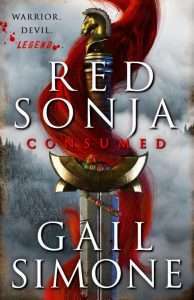 As a character, Red Sonja has a long and involved history. While working on Conan the Barbarian for Marvel Comics, writer Roy Thomas and artist Barry Windsor-Smith came up with the character as a female foil to Conan. They looked to original Conan creator Robert E. Howard for inspiration, taking the swashbuckling heroine “Red” Sonya (note the Y, not J) of Rogatine from Howard’s 1934 historical adventure “The Shadow of the Vulture,” transplanting her in heavily modified form from 16th century Vienna to Conan’s Hyborian Age. Given a revealing costume (albeit not initially the armored bikini with which the character would later become indelibly associated) and dramatic origin story, Red Sonja became an instant hit after her introduction in 1973. In addition to numerous appearances within the pages of Conan the Barbarian, Red Sonja went on to star in her own comic titles, first at Marvel and currently at Dynamite Entertainment.
As a character, Red Sonja has a long and involved history. While working on Conan the Barbarian for Marvel Comics, writer Roy Thomas and artist Barry Windsor-Smith came up with the character as a female foil to Conan. They looked to original Conan creator Robert E. Howard for inspiration, taking the swashbuckling heroine “Red” Sonya (note the Y, not J) of Rogatine from Howard’s 1934 historical adventure “The Shadow of the Vulture,” transplanting her in heavily modified form from 16th century Vienna to Conan’s Hyborian Age. Given a revealing costume (albeit not initially the armored bikini with which the character would later become indelibly associated) and dramatic origin story, Red Sonja became an instant hit after her introduction in 1973. In addition to numerous appearances within the pages of Conan the Barbarian, Red Sonja went on to star in her own comic titles, first at Marvel and currently at Dynamite Entertainment.
While a handful of Red Sonja prose novels exist, Red Sonja: Consumed is the first to be published since 1983. This novel is also notable for its author: Gail Simone. Not only is Simone an experienced Red Sonja writer, her 2013 19-issue Dynamite Entertainment run with the character is one of the most acclaimed in the character’s multi-decade history. And while various authors have had many different portrayals of the character, in this reviewer’s opinion, Simone’s is the most fun. Sexual assault is often a part of Red Sonja’s backstory, as an inciting incident that (along with some divine intervention in the form of a sympathetic goddess) leads her to become an indomitable swordswoman. Sonja is often depicted as adhering to a vow of chastity, refusing to be bedded by any man unless he bests her in combat. Both in her tenure on the comic and in this novel, Simone dispenses with all of that. No rape-based origin story, no goddess, no vow of chastity. Simone retains Sonja’s fearlessness and deadly allure, but she’s no longer a warrior nun. Simone’s Sonja is earthy. She still wears the trademark bikini, but one gets the sense that she wears it for herself, not to titillate every alehouse yokel. She’s brave and capable, but occasionally surly, spiteful, and flippant. She doesn’t always have the best hygiene or odor about her. Her carousing sometimes gets her in trouble. Far from chaste, she’s both pansexual and voracious (regrettably absent from the novel, “I’m Red Sonja, I’m everybody’s type” is a memorable quote from Simone’s comic run). Simone allows her to be an imperfect mercenary swordswoman with both admirable qualities and flaws, who enjoys the full spectrum of pleasures permitted by her freewheeling lifestyle. Happily, the heroine presented in Red Sonja: Consumed is the same one we know from Simone’s reign on the comic.
Appealing characterization aside, perhaps inevitably, Red Sonja: Consumed reads like a first novel from an established comic book creator. The pace remains speedy throughout, but the plot wanders before tightening up in the last third of the book. While infrequent, there are jarring instances of “head hopping,” where the perspective wanders between multiple characters within a single scene. Betrayed queen Ysidra and the psychotic assassin Sylus are compelling characters, but they disappear for long stretches of the narrative, to the story’s detriment. The setting of the novel—still the same Hyborian Age inhabited by Conan, even though the characters have different ownership today—is somewhat vaguely rendered, but that seems a perennial issue with the Red Sonja comics as well.
On the positive side of the ledger, however, Simone’s background as a comic writer results in intensely vivid visuals. Throughout the novel I found myself effortlessly imagining various events as full-page comic spreads. Combat scenes are frequent, graphic, and vicious. Sonja brutally dismantles her opponents, going the extra mile to make sure they stay down permanently. The supernatural threat that reveals itself late in the book is also presented in a deliciously creepy manner.
While there are some rough edges, Red Sonja: Consumed is a fast-paced and entertaining dark Sword & Sorcery novel. The book is an easy recommendation to existing fans of Simone’s work on the Red Sonja comic book, but no prior experience with the character is necessary. Readers with a strong emotional investment in the more classic depiction of the character, with the assault survivor and vow of chastity elements intact, might balk somewhat at the messier heroine Simone presents us with, however. Feisty fantasy heroines are more common now than in decades past, but Red Sonja remains one of the best. While I enjoy and respect the work of earlier creators like Roy Thomas and Frank Thorne, Gail Simone’s rendition is the most modern and fun.
Read Red Sonja: Consumed by Gail SimoneThe post REVIEW: Red Sonja: Consumed by Gail Simone appeared first on Grimdark Magazine.
February 20, 2025
REVIEW: The Witcher: Blood Origin
Set over a thousand years before Netflix’s hit The Witcher series, The Witcher: Blood Origin takes viewers back to the conjunction of the spheres at a time when ancient Elven civilization of Xin’trea is thriving prior to its demise, and of course, the creation of the first Witcher.
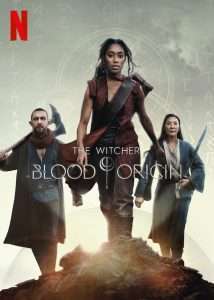 Blood Origin begins with everyone’s favourite bard, Jaskier, almost dying in battle but he is saved as time is frozen and a mysterious figure tells him the tale of seven warriors who overthrew an evil empire. Jaskier is used to link Blood Origin to the main Witcher series and the four-episode run falls foul of many of the issues that plagued that series without the efforts of Henry Cavill to save it.
Blood Origin begins with everyone’s favourite bard, Jaskier, almost dying in battle but he is saved as time is frozen and a mysterious figure tells him the tale of seven warriors who overthrew an evil empire. Jaskier is used to link Blood Origin to the main Witcher series and the four-episode run falls foul of many of the issues that plagued that series without the efforts of Henry Cavill to save it.
Fans of fantasy will enjoy this series as casual, background viewing. Much of the plot, setting, and writing will feel familiar to many viewers – for some it may be comforting, for others, it will feel as though the show is not trying hard enough. The Continent is a world that is unforgiving with ruined landscapes, raw violence, and little room for heroism. We have kings and queens, dark wizards vying for power, and pretty much every character out for revenge. The action is brutal and gritty and well-worth tuning in for but with a political tale of revenge at its heart and so much to set up, the four-episode arc doesn’t allow for enough time to make you feel that this is a lived-in world or to see the growth of the main cast.
There is so much potential with the cast in Blood Origin. Michelle Yeoh (Star Trek, Crouching Tiger, Hidden Dragon), Lenny Henry (The Rings of Power), and Laurence O’Fuarain (Game of Thrones) have all proven themselves capable in fantasy TV series and do well with what they are given, but Blood Origin lacks the depth and complexity of their other shows. Michelle Yeoh brings gravitas as Scían, a character steeped in loss and vengeance, and the dynamic between the bunch of misfits forced together through their own vows of vengeance offer glimpses of quality but this is no Seven Samurai. The visuals are similar to the main series – lots of muted colours and greys balanced by golden hues of the Elven world in slow decay. The battle scenes are shot well and have a chaotic, brutal feel to them that will delight fans as this is where Blood Origin works best. Limbs are lost, wounds are bloody, and death is everywhere. There are consequences and that will be something that hits with fans of grimdark but the show still doesn’t hit the heights of series such as Game of Thrones or The Last Kingdom.
There are some positives in Blood Origin that make the show worth a watch for fans of TV fantasy but the lack of depth to the show is a disappointment. Great battles and a strong cast are weighed down with a rushed series that could have been so much more. Fans of The Witcher books will dislike the liberties taken with the story but the battle scenes and familiar fantasy setting may be enough for casual fantasy fans.
The post REVIEW: The Witcher: Blood Origin appeared first on Grimdark Magazine.
February 19, 2025
REVIEW: A Conventional Boy by Charles Stross
A Conventional Boy by Charles Stross is the thirteenth of the fourteen book his Laundry Files series. The Laundry Files is a series based around an obscure British intelligence agency that deals with the monsters and horrors of a Cthulhu Mythos inspired world. Charles Stross’ Laundry Files is somewhere between Terry Pratchett, John Le Carre, and H. P. Lovecraft. The books swing wildly from hilarious send ups of more serious fiction and genuinely terrifying stories. They also bring up some fascinating concepts regarding math, politics, religion, and relationships where your partner’s violin wants to kill you.
 It is questionable whether the Laundry Files series qualifies as horror novels but I’d dare say they do and the most terrifying things about them are the realism-induced elements. The Apocalypse Codex, for example combines a Dominionist evangelist cult with Cthulhu but it is elements from real-life fundamentalism that are the most disturbing. A Conventional Boy‘s horror comes from its invocation of the actual Satanic Panic of the 1980s and how it’s never really gone away.
It is questionable whether the Laundry Files series qualifies as horror novels but I’d dare say they do and the most terrifying things about them are the realism-induced elements. The Apocalypse Codex, for example combines a Dominionist evangelist cult with Cthulhu but it is elements from real-life fundamentalism that are the most disturbing. A Conventional Boy‘s horror comes from its invocation of the actual Satanic Panic of the 1980s and how it’s never really gone away.
Charles Stross gives an extended explanation of this in the Afterword, and enough information in the book to understand it for those who blessedly never heard of it, but the short version is: in the Eighties that a lot of televangelists like Jerry Falwell decided to motivate their followers by claiming X thing was literally invoking Satanic forces. He only touches the tip of the iceberg, but the ridiculous premise was that Dungeons and Dragons books allowed you to summon demons or be possessed by them. It’d be funny if not for the child abuse and witch hunts that ensued.
This is all a rather extensive opening to explain that Derek Reilly was an adolescent in 1984 when the actual occult authorities scooped him and his friends up before institutionalizing them as potential evil wizards. The others eventually were let go but Derek’s autism and social awkwardness resulted in him being treated as a threat. This is particularly notable to me as I have had that kind of fear myself as a neurodivergent person.
Derek ended up spending forty-years in a camp for deprogramming wizards and cultists with his only release being a literal play by mail game once his handlers realized he was harmless but knew too much. Now, with the camp about to be shut down, the nearly-fifty Derek breaks out of his camp to go to a roleplaying game convention. A convention that is filled with cultists but ones that have wandered in from a much more likely source of Satanic power in the real world: corporate marketing culture.
I’ve read virtually the entirety of the Laundry Files and much of Charles Stross’ other work but find that A Conventional Boy resonates with me more than any of the others. The sheer unfairness if Derek’s life has immense pathos. Tabletop gaming has a special role in the minds of many neurodivergent people and the fact it was used to ruin his life is all too believable. Perhaps the story would not hit so hard if I didn’t know fundamentalist families who forced their children to burn their tabletop game supplements.
I have a few minor issues with the story as it really ends a bit too happily given the circumstances. Also, I feel like the climatic final struggle against corporate RPG culture would have been better with a confrontation against the people who imprisoned Derek (and are depersonalized drones of bureaucracy versus someone specific who signed off on imprisoning him decades ago) but I still enjoyed the book. Very much so. There’s a couple of short stories as well.
A Conventional Boy is good, very good. It can also be read effectively as a standalone volume of the series or even an introduction to The Laundry Files. You can start with Derek Reilly’s story to see if the world is for you before trying The Atrocity Archives. I think this is a series well worth picking up and A Conventional Boy is one of the best parts of it.
Read A Conventional Boy by Charles StrossThe post REVIEW: A Conventional Boy by Charles Stross appeared first on Grimdark Magazine.
February 18, 2025
REVIEW: An Inkling of Flame by Z.B. Steele
The universe needs more grimdark novellas, and Z.B. Steele delivers in spades with An Inkling of Flame. Although the novella can be read as a standalone volume, it also serves as a gateway to the author’s A Song of the Damned series. An Inkling of Flame tells the story of Layne, a soldier conscripted to fight in service of a deity known as the Fox.
 The influence of Anna Smith Spark runs deep throughout An Inkling of Flame, especially in the latter part of the novella. One of the main characters is even named after our beloved Queen of Grimdark. Like much of Anna Smith Spark’s work, An Inkling of Flame takes the perspective of everyday soldiers as they are forced to fight in someone else’s war. A particular highlight of the novella is the camaraderie that forms among Layne and his fellow soldiers, which lends a comforting found family feel to this grimdark world.
The influence of Anna Smith Spark runs deep throughout An Inkling of Flame, especially in the latter part of the novella. One of the main characters is even named after our beloved Queen of Grimdark. Like much of Anna Smith Spark’s work, An Inkling of Flame takes the perspective of everyday soldiers as they are forced to fight in someone else’s war. A particular highlight of the novella is the camaraderie that forms among Layne and his fellow soldiers, which lends a comforting found family feel to this grimdark world.
An Inkling of Flame is a very well written novella, with carefully polished prose that delivers grimdark grit interspersed with moments of levity coming from the banter among characters. An Inkling of Flame is compulsively readable—I couldn’t put it down and finished the whole novella in a single session.
Z.B. Steele also makes effective use of a framing narrative as Layne recounts his story to an inquisition in the aftermath of battle. Although the framing story appears at first to be superfluous, its importance becomes clear during a few well-placed interludes and the gut-wrenching conclusion of the novella.
An Inkling of Flame establishes Z.B. Steele as a rising star in grimdark as he pays homage to classic grimdark tales while offering a fresh new story with surprising emotional depth. A Song of the Damned continues with Whispers of the Storm, the first full-length novel in the series.
Read An Inkling of Flame by Z.B. SteeleThe post REVIEW: An Inkling of Flame by Z.B. Steele appeared first on Grimdark Magazine.
February 17, 2025
REVIEW: A Drink Before We Die by Daniel Polansky
If you’ve read the Low Town Trilogy (The Straight Razor Cure, Tomorrow, the Killing, She Who Waits) and you’re looking for a little more of that The Warden awesomeness (or this is your first Low Town and you’re wondering if you need to start reading the trilogy), then look no further—I have just the short story for you. A Drink Before We Die is a brilliant little 20-odd minute read that gives you a nice little taste of Daniel Polansky’s incredible ability to deliver amazing grimdark fantasy stories set in a post-war world where hard, brutal people, do hard brutal things, and The Warden manipulates the hell out of all of them.
 The Warden runs Low Town, a rough-as-guts slum part of Rigus. He deals the drugs, runs the streets, knows the people, and controls the crime through knowing everything about everyone, and killing the rest. From across the river, Cosgrave is looking to expand his business into Low Town—looking to eat from The Warden’s table, and then likely own it. He’s all balls and bustle, confronting The Warden in The Warden’s house of business he owns with his old war buddy Adolphus with all pretend niceness and snideness of a mafia don.
The Warden runs Low Town, a rough-as-guts slum part of Rigus. He deals the drugs, runs the streets, knows the people, and controls the crime through knowing everything about everyone, and killing the rest. From across the river, Cosgrave is looking to expand his business into Low Town—looking to eat from The Warden’s table, and then likely own it. He’s all balls and bustle, confronting The Warden in The Warden’s house of business he owns with his old war buddy Adolphus with all pretend niceness and snideness of a mafia don.
As you already know, or will come to know, The Warden isn’t having a dash of that. The Warden picks up what Cosgrave is putting down and immediately moves to action in the way that only The Warden does, eschewing ranks of hired muscle for smarts and manipulation.
A Drink Before We Die is a nice little slice of The Warden’s life—a vignette of manipulation and violence, if you must. As a tie in short story, it does everything you want. It doesn’t rely on you knowing the world or having read the trilogy to understand what’s going on. It gives you a taste of the key characters and the kind of story you’ll read in the novels. Is a complete, stand-alone short story, with a finished arc that hints at the greater story without relying on it. Whenever I’m asked about what we look for when procuring tie-in short stories, A Drink Before we Die will join Mark Lawrence’s Bad Seed as my answer as the best examples I can remember reading.
Polansky has long proven himself an excellent proponent of long form storytelling (Those Above, Those Below, Tomorrow’s Children), then delivered in spades in novella length (The Builders), and now I can confirm Polansky can dominate in short story form as well.
Read A Drink Before We Die by Daniel PolanskyThe post REVIEW: A Drink Before We Die by Daniel Polansky appeared first on Grimdark Magazine.
February 16, 2025
In the Shadow of their Dying now available in Audio! Listen to Chapter One here.
There is something special about the extra dimension of creativity introduced to a book by having it delivered by a brilliant voice actor like Emma Gregory. When we signed on to partner with W.F. Howes to produce the audio version of In the Shadow of their Dying by Anna Smith Spark and Michael R. Fletcher, the authors and I were incredibly excited about what W.F. Howes could create from Anna and Mike’s work.
I think, and I hope you’ll agree, it’s something fucking magnificent.
About Emma GregoryEmma is a highly experienced, 5-star audiobook narrator and is well known for her performances within the Warhammer audiobooks and audio dramas by Games Workshop. Emma has gathered a large fan base for her work across Warhammer 40k, and especially for her role as Minthara in the multi-award-winning game, Baldur’s Gate 3 for which she was put forward for BAFTA consideration.
Listen to Emma bring In the Shadow of their Dying to lifeI love Emma’s ability to slip between gritty voices for the range of human and demon characters, bringing the tension and action and laughter from the page into your ears. Use the below to listen to 35 glorious minutes of Emma Gregory narrating chapter one of In the Shadow of their Dying and grab yourself a copy from Amazon / Audible, here.
https://www.grimdarkmagazine.com/wp-content/uploads/2025/02/In-the-Shadow-of-their-Dying-Chapter1-video.mp4Listen to In the Shadow of their Dying by Anna Smith Spark and Michael R. FletcherThe post In the Shadow of their Dying now available in Audio! Listen to Chapter One here. appeared first on Grimdark Magazine.
February 15, 2025
REVIEW: Behind Blue Eyes: The Graphic Novel by Anna Mocikat
Behind Blue Eyes: The Graphic Novel #1 by Anna Mocikat and illustrated by Ivano Lago is a fantastic cyberpunk comic book that shows that independent creators are rapidly developing the ability to compete with larger imprints. It is based on the indie science fiction series of the same name but serves as a standalone story that is roughly the size of two normal-sized comics at 77 pages. There are no advertisements within the comic, and it is a bit text heavy but filled with beautiful sequential art.
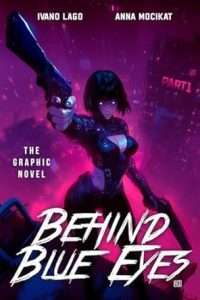 The premise for Behind Blue Eyes: The Graphic Novel is that the world has been taken over by oppressive corporations with the Olympias Corporation ruling the Western Hemisphere. Olympias is good at appearing liberated, though. Its population is kept in access to brain numbing media, sex, and drugs to keep its people compliant. This keeps the public from also resisting the fact they have banned books, religion, immigration, and regularly engage the public with death squads that eliminate those who seemingly threaten the state. It should be noted Anna Mocikat is a woman from Poland and is just the right age to have lived under totalitarianism.
The premise for Behind Blue Eyes: The Graphic Novel is that the world has been taken over by oppressive corporations with the Olympias Corporation ruling the Western Hemisphere. Olympias is good at appearing liberated, though. Its population is kept in access to brain numbing media, sex, and drugs to keep its people compliant. This keeps the public from also resisting the fact they have banned books, religion, immigration, and regularly engage the public with death squads that eliminate those who seemingly threaten the state. It should be noted Anna Mocikat is a woman from Poland and is just the right age to have lived under totalitarianism.
Nephilim is one of the many children of the state’s victims that have been kidnapped from their parents or acquired through other means before being put through a state-run education that exists to turn them into soldiers. Much of the comic is devoted to depicting Nephilim as she goes through the horrifying physical changes as well as indoctrination that the Olympias Corporation needs from its Guardian Angels. This is all framed through the lens of a flashback occurring while Nephilim is leading the attack on a bunch of refugees hiding away from the Olympias Corporation in the woods.
Behind Blue Eyes: The Graphic Novel is a very dark and oppressive story that is nevertheless incredibly beautiful to read. The artwork is beyond stunning and very reminiscent of Ghost in the Shell. The character designs are beautiful and manage to run the line between sexy and foreboding. It is not exactly anime/manga, being slightly more realistic, but it invokes it enough to remind you of Eighties cyberpunk.
Behind Blue Eyes: The Graphic Novel is better if you’ve read the Behind Blue Eyes novel series, but it isn’t essential to know the series beforehand. On its own, it’s a pretty straightforward and enjoyable tale of a woman being indoctrinated into a soldier for the megacorps and the people trying to resist. It’s also got fantastic art that perfectly encapsulates a cyberpunk aesthetic. Its visual style is reminiscent of several things I’ve enjoyed but also unique.
In conclusion, I really recommend Behind Blue Eyes: The Graphic Novel as something for cyberpunk and grimdark fans to check out. If you enjoy it, perhaps you should check out the book series. Hopefully this graphic novel might also lead to other comics set in the universe. Anna Mocikat has created a really lovely work of art here and I think it’s well worth the money to pick up.
Read Behind Blue Eyes: The Graphic Novel by Anna MocikatThe post REVIEW: Behind Blue Eyes: The Graphic Novel by Anna Mocikat appeared first on Grimdark Magazine.
February 14, 2025
REVIEW: Cursebound by Saara El-Arifi
Saara El-Arifi returns to her magical world of fae and elves with Cursebound, the second novel in The Faebound Trilogy. The opening novel in this series, Faebound, was the first of El-Arifi’s books I had ever read, so I happily returned to this fantastical land eager to find out what was in store next for elven sisters Yeeran and Lettle.
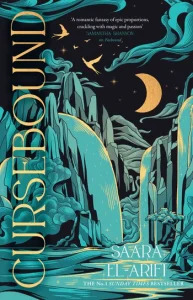 Luckily for me (and something I always appreciate when reading subsequent books in a series), El-Arifi begins Cursebound with a brief synopsis of the first novel’s events, so although Faebound must be read first, no reread is required. Huzzah! There is also a “Notes on Mosima” reference at the end of the novel, which is full of extra tidbits of world-building if you are the sort of reader who likes to know even more about the world you have been exploring.
Luckily for me (and something I always appreciate when reading subsequent books in a series), El-Arifi begins Cursebound with a brief synopsis of the first novel’s events, so although Faebound must be read first, no reread is required. Huzzah! There is also a “Notes on Mosima” reference at the end of the novel, which is full of extra tidbits of world-building if you are the sort of reader who likes to know even more about the world you have been exploring.
After the events of Faebound, Yeeran and Lettle are no longer prisoners of the fae. Yeeran, a formidable warrior, finds herself fighting a battle she is unprepared for – love. Torn, she leaves her fae lover, the Queen Furi, to travel back to the homeland that exiled her to warn them of the grave new dangers they face in their endless war. Lettle, the seer, now holds an esteemed place in the fae court as a diviner and consort to the half-fae king, Rayan. Her determination to break the curse, which binds all of the fae to remain in Mosima, will lead her down a deadly path. One that is made harder now that the fates are silent whenever she tries to speak with them.
If you enjoyed reading Faebound, which I did, you will find much to like in Cursebound. El-Arifi has continued the series with very easy-to-read, well-paced chapters. The novel is around 350 pages long, and I read it easily within a few days. Her world is not an overly complex one to settle into, and the perspectives of all the characters, even new ones, are easy to keep track of, and the narrative flows very nicely. Cursebound is a queer norm, magical world, and focuses mainly on the two races of the fae and elves rather than humans. There are some politically intriguing parts, some slightly darker moments, a varied group of characters from the ensemble cast, and a smattering of romantic relations.
However, Cursebound is not particularly dark. El-Arifi focuses here on the characters and their relationships rather than the more military epic fantasy readers may be familiar with from her first trilogy, The Ending Fire. Hopefully, as Cursebound is this trilogy’s second instalment, readers will already be aware of these differences and expect them as they continue the story. If you prefer your reads to be grimmer and darker and not to have romance form a key part of the plot, you might not enjoy The Faebound Trilogy as much as El-Arifi’s other works.
Cursebound still sits firmly in the realm of books I enjoy reading, and I liked the escapism it gave me for a few days. Although it does suffer a little from middle-book syndrome, Cursebound has set the stage well for the final instalment in the trilogy, and I look forward to the conclusion of this tale when it arrives. Thank you very much to Saara El-Arifi and the team at Harper Voyager for sending an ARC of Cursebound for us to review.
Read Cursebound by Saara El-ArifiThe post REVIEW: Cursebound by Saara El-Arifi appeared first on Grimdark Magazine.

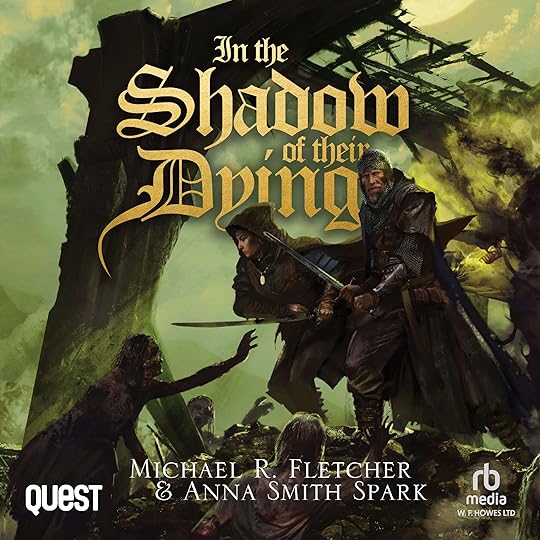 Listen on Audible
Listen on Audible

